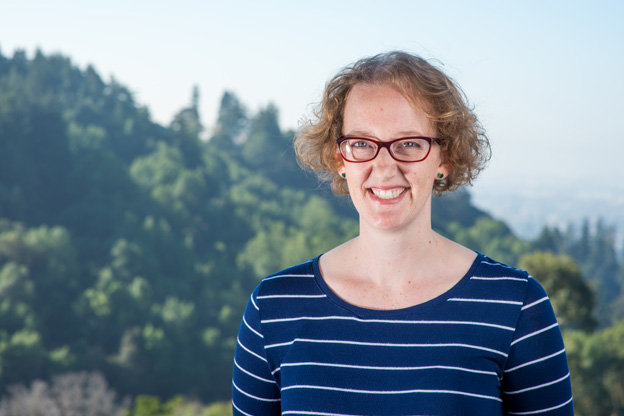 The new user services group leader is coming to the ALS from our neighboring user facility, the Molecular Foundry, where she has been supporting and collaborating with users for 15 years. Outside of the lab, she is a track and field coach, yoga instructor, and children’s book author.
The new user services group leader is coming to the ALS from our neighboring user facility, the Molecular Foundry, where she has been supporting and collaborating with users for 15 years. Outside of the lab, she is a track and field coach, yoga instructor, and children’s book author.
What part of joining the ALS is most exciting to you?
I have been very active in the Molecular Foundry user program, and as part of that, I was really interested in ALS and how they operated. Six years ago, I became a user at ALS to understand how the process works and to start getting access to the beamlines to do research and collaborate with the scientists. It was a lot of fun, though exhausting, and I’m really excited to go beyond the user side and to step into more of an administrative role on your leadership team.
What was your beamtime experience like?
My research focused on plasmonic nanoparticles, mostly metal hexaborides, which were designed to absorb solar heat on windows. I started on Beamline 12.2.2 when they first developed their heating setup. It’s a pressure beamline, but I did work that was not under pressure, heating our samples while measuring x-ray diffraction to learn about reaction mechanisms. I like to mentor students a lot, so I brought my mentees with me to explore how transitions in our crystal lattices happened. We found that different components of our starting materials were trapped inside the final product, which was unexpected. It really changed the direction of the science we were doing.
I’ve been very fortunate in working with the ALS beamline scientists, and every beamtime that we had resulted in a publication, which I know is not always the case. We did as much leg work as possible before beamtime, collecting as much data at the Foundry as we could before our experiments were scheduled at ALS. Every time we walked in the building we had a list of samples to analyze and a contingency plan in case something was unexpected or went wrong (which was common). We had a small window of time to do the work, and were lucky that our planning resulted in some really big gains.
What drew you to mentoring students?
Several years ago, I knew a Science Undergraduate Laboratory Internship (SULI) student who was working in the wrong field for her interests. She was a senior in undergrad and thought she should give up science and change fields. After a few discussions to get at the heart of the problem, she became my first official intern. We focused on a completely different type of science, doing synthetic work and exploring chemical reactions. She enjoyed the experience and went on to become a very successful graduate student.
Since then, I tend to select mentees who have no background in our field and therefore no bad habits. It’s challenging the first few weeks because they don’t have any past experience, but if you find someone who is truly motivated about science and genuinely wants to learn, you can guide them in the direction they need to go. I’m a big believer in giving people a chance, and always make sure my students have choices and own a part of their project.
What inclusion, diversity, equity, and accountability (IDEA) efforts are you involved in?
I’m very motivated working with young women and children that are less represented. I used to volunteer at the Richmond schools science fairs, and I especially like working with students who don’t have past experience—taking on someone who hasn’t done an internship before, or doesn’t have the 4.0 GPA. I think giving those students an opportunity is really helpful. On the other side of the IDEA topic, sometimes people forget that diversity of opinion matters, too. I’m always the one who is encouraging people to share their opinions in a discussion, even if their ideas conflict with everyone else’s thoughts. You can learn a lot in a group that challenges your views and feels comfortable sharing.
What do you like to do in your free time?
My free time is often filled with projects or classes. I teach pelvic floor yoga online, helping people with the muscles no one wants to talk about. It’s not a common specialty, but hearing student success stories makes it worth the time commitment. I enjoy writing children’s stories to help keep my kids interested in reading, and have published Nancy Nano at the lab and the Dragon Ponies series on Amazon. Last year, I was also the head middle school coach for both cross country and track, and am an active parent. Apparently, I don’t like to be bored!